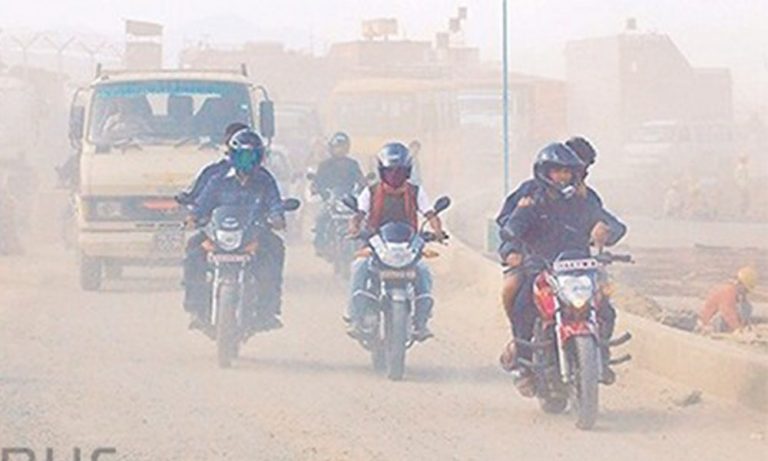
2015-12-19, Pragati Shahi
With air pollution hitting hazardous levels in Delhi and Beijing, the respective governments are scrambling to put in place desperate measures to control emissions. But in Nepal’s capital city Kathmandu, which also chokes beneath a blanket of pollution, there is neither data nor any proper information available regarding air quality.
The government seems to be in a fog about the presence of harmful pollutants, including particulate matter (PM) and dust particles that could cause cancer, in the air that the Valley denizens are breathing. The level of exposure and extent of threat to public health due to the pollution largely remain unknown.
“The winter concentrations of particulate matter, dust, dirt, soot and smoke, along with diesel exhausts, are high,” said Jagadish Bhakta Shrestha, Director General at the Department of Environment (DoE), the authority responsible to make public air pollution status. “However, at the moment, we are not in a position to say the status of air pollution and its effect on public health.”
“We are already overwhelmed with the programmes to implement and with limited human resources and funds, we are unable to priortise our activities,” he added.
Various independent researches carried out at different intervals have stated that Kathmandu residents are already “choking”.
The Ministry of Environment, in its air quality report in 2005, stated that winter concentrations of particulate matter were similar to those in highly polluted Indian cities like New Delhi. In the last one decade, the number of vehicles in the capital city, with a population of around 2 million, has tripled.
Two-thirds of the deadly pollutants are caused by vehicle emissions and dust.
As per a report published by the Nepal Health Research Council and the World Health Organisation in 2009, an estimated 1,926 prem-ature deaths occur in Kathmandu every year due to air pollution.
In 2014, the Yale Environmental Performance Index ranked Nepal as the second most polluted country in the world, after Bangladesh, ranking Nepal’s air quality at 177th out of 178 countries, with the level of small particulate matter (PM 2.5) measuring over 500 micrograms per cubic metre.
The level is 20 times more than the World Health Organisation’s safe upper limit. When Paris resorted to banning cars, the level had peaked to over a fifth of that: 110 micrograms per cubic metre.
Between 2000 and 2003, six stations were set up with the help of the Danish aid agency in Kathmandu. But data now are hard to come by, as the stations have remained dysfunctional since 2007. No efforts have been made to measure air quality inside the Valley since. Without a single air quality monitoring station to measure the level of life-threatening fine particles of air, the Kathmanduites are unaware of quality of the air they are breathing in.
According to Surendra Subedi, Deputy Director General at DoE, the government has allocated Rs 51 million to set up air quality monitoring stations in the Kathmandu Valley and various organisations like the Asian Development Bank and International Centre for Integrated Mountain Development have agreed to support this year to monitor air quality.
“We plan to install 11 monitoring stations with nine in Kathmandu and two outside the Valley–one each in Lumbini and Chitwan–to monitor trans-boundary pollution. This will take some time,” Subedi said.
Oblivious to rising threat level
- The Ministry of Environment, in its air quality report in 2005, stated that winter concentrations of particulate matter were similar to those in highly polluted cities of the world
- In the last one decade, the number of vehicles in the capital city, with a population of around 2 million, has tripled
- Two-thirds of the deadly pollutants are caused by vehicle emissions and dust
- In 2014, the Yale Environmental Performance Index ranked Nepal as the second most polluted country in the world, after Bangladesh
- Level of small particulate matter is said to measure over 500 micrograms per cubic metre, or 20 times the World Health Organisation’s safe upper limit.
- Between 2000 and 2003, six stations were set up with the help of the Danish aid agency in Kathmandu
- With the stations remaining dysfunctional since 2007, data on the level of population are not available




